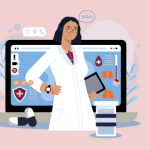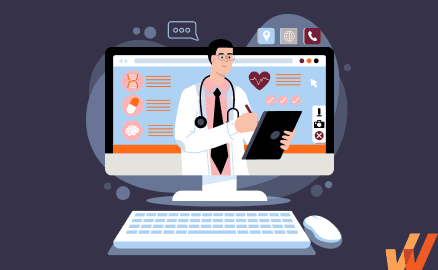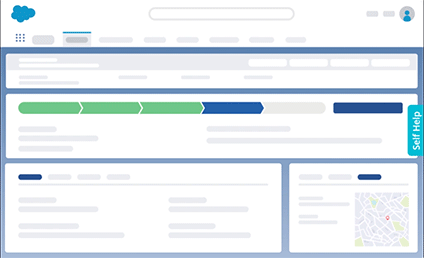

Drishti Chawla


The healthcare industry has been undergoing a profound transformation driven by digital technologies in recent years. According to the Accenture 2019 digital health technology vision report, it is estimated that more than 80 percent of healthcare leaders globally have adopted digital transformation initiatives.
From electronic health records to telemedicine and artificial intelligence, digital transformation revolutionizes how healthcare is delivered, experienced, and managed. It can address 95% of adverse drug instances like medication errors, overdoses, and allergic reactions. Hospitals can save lives with improved compliance guidelines and incur cost savings of 7-11%.
This article explores the key aspects of digital transformation in healthcare, highlighting its impact on patient care and overall healthcare outcomes.
Digital transformation in healthcare means the use of digital technologies, tools, and platforms to improve the quality of healthcare delivery, enhance patient experience, and enable better healthcare outcomes. Electronic healthcare records, telemedicine, health apps, wearable devices are all a part of the digital transformation revolution in healthcare.
Here are a few most significant use cases of digital transformation in healthcare.
Digital transformation enables hospitals and service providers to collect and analyze patient data in order to provide personalized healthcare experience. Digital solutions like Electronic Health Records (EHRs), telemedicine, and Remote Patient Monitoring (RPM) help improve patient participation, increase provider collaboration, and lower the risk of errors in healthcare.
Digital transformation helps streamline hospital operations by eliminating mundane tasks while reducing administrative effort. The reduction of manual tasks helps healthcare staff focus more on patient care. Digital tools such as patient scheduling systems, inventory management systems, and electronic billing systems allow the most optimized utilization of human resources.
Furthermore, the use of predictive analysis based on past data helps predict demand and enables hospitals to allocate resources beforehand. This also allows the medical service provider to optimally handle medical inventory, which can be crucial in a crisis.
Digital transformation has made analyzing a patient’s disease history easier and efficient. Disease history analysis tools provide doctors with recommendations about treatment outcomes.
Boston Gene can serve as a good example here. The company provides a unique solution that performs sophisticated analytics to aid clinicians in evaluating viable treatment options for each patient’s genetics, clinical characteristics, and disease profile.
Digitally transforming the supply chain can reduce process costs by 50 percent and increase revenue by 20 percent. The process of ordering, reconciling, and paying for medical, surgical, and pharmaceutical supplies can be automated using technology. This decreases the cost burden on inventory management and supply chain. A robust supply chain management system helps hospitals cope with supply side shocks in case of emergencies like the COVID-19 pandemic.
Another leading technology in healthcare trends is patient portals. These are platforms where patients can access their health records, schedule appointments, message their doctors, etc. A survey of health systems found that 82% consider patient portals one of their primary technologies for engaging patients.
This trend promotes convenience and transparency. People can easily see their test results, care histories, and visit notes from doctors—all online. They can easily share this data with multiple providers, eliminating the need to call and manually transfer records. This is more convenient for the patient and reduces the burden on office staff.
One example is FollowMyHealth, a platform that multiple healthcare systems use.

With FollowMyHealth, patients can use the same platform for general medicine and specialist visits. They can message doctors and access their complete medical histories from one central location.
Implementing a digital adoption platform for onboarding can accelerate patient portal adoption significantly via interactive walkthroughs, in-app guidance, and 34*7 self-help support. This enables users to take full advantage of everything the online portal has to offer.
While patient portals help pull data on the patient end, many hospitals are also working on aggregating back-end data. Currently, doctors’ offices have data coming in from a wide variety of sources, including:
With all of these sources, it’s easy to overlook important patient medical history data. Data aggregation enables fast, informed patient-care decisions, and doctors don’t have to worry about missing key information.
The top goals driving data aggregation are improved patient care and lower costs. All of the data for a patient is brought together to create a comprehensive profile. Having a single source of truth reduces the time staff spends sorting through patient data and paperwork, resulting in lower patient wait times and fewer administrative hours.
Mayo Clinic is pursuing data aggregation by partnering with Google to implement cloud solutions. They use the cloud to host data storage and analytics all in one place. Google’s cloud offers a single, secure location for storing, organizing, and accessing patient data, allowing for more comprehensive diagnostics. At the same time, Google’s cloud computing and artificial intelligence (AI) capabilities will aid in the Mayo Clinic’s research efforts.
Hospitals can leverage digital transformation to improve their overall operational efficiency, enhance patient care, improve a hospital’s financial performance, and enhance security and compliance. Here are some of the most significant benefits of digital transformation in healthcare and pharma digital transformation.
Digital transformation in healthcare helps optimize workflows for the staff. Essential data like patient’s vitals, hospital’s resources, and treatment period can be collated to create an accurate predictive analysis. Even minor tasks like hospital equipment tracking can be automated with the help of technology. This helps improve the effectiveness and efficiency of the healthcare industry.
Digital transformation focuses on the use of IoT and software for mundane tasks, reducing the costs, and improving financial performance of the healthcare service providers. By reducing costs, improving revenue cycle management, and enabling new revenue streams, a healthcare service provider can have more financial strength to purchase advanced machines or upgrade existing facilities.
Digital transformation allows hospitals to have robust data security, eliminating privacy concerns or threat of data manipulation. Regulatory compliance can be made easy with blockchain. Blockchain can be used to record financial transactions and patient data, allowing the data to be secure and leaving no room for manipulation.
Patients satisfied with the services of their healthcare provider bring in recurring revenue. Hence, customer experience is of prime importance to a healthcare provider. Digital transformation helps enhance the customer experience through telemedicine and patient portal for easy access to test reports and appointments.
Real-time data enables healthcare providers to make informed decisions promptly. They can access real-time patient information, such as vital signs, lab results, or medication history, allowing for timely interventions and treatment adjustments. Patient outcomes immediately get positively impacted since the healthcare providers have all the latest essential information they would require for decision making.
Here are the top digital technologies that should be implemented in a hospital.
Electronic Health Records (EHR) are digital versions of patients’ medical records and health information. They contain comprehensive and up-to-date information about a patient’s medical history, diagnoses, medications, allergies, immunizations, laboratory results, and other relevant health data. Electronic Health Records are a replacement of the traditional pen and paper method of storing patient data.
To implement effective in-app EHR training to boost EHR adoption, consider implementing a digital adoption platform such as Whatfix. Whatfix’s in-app guidance allows you to generate custom onboarding flows that overlay on top of your software. Furthermore, customized tooltips, popup recommendations, and a self-help widget pull data from your knowledge base to support employees all the way through the software adoption process.
A digital adoption platform (DAP) plays a crucial role in boosting digital transformation in healthcare by providing a seamless and personalized user experience. By offering interactive in-app guidance, step-by-step tutorials, and real-time support, a DAP empowers healthcare professionals to quickly and effectively adopt new digital tools and technologies. It eliminates the learning curve associated with digital solutions, improves user proficiency, and accelerates the integration of digital tools into everyday workflows.
Additionally, a DAP enables data-driven insights by collecting user interactions, allowing healthcare organizations to identify areas for improvement and optimize the usage of digital platforms. With its ability to streamline the adoption process, enhance user engagement, and drive digital proficiency, a DAP becomes a catalyst for successful digital transformation in healthcare, ultimately leading to improved patient care and outcomes.


A Hospital Management System (HMS) is a software solution designed to automate and streamline various administrative, operational, and clinical processes within a hospital or healthcare organization. A Hospital Management System is implemented to streamline operations, improve efficiency, enhance patient care, and optimize resource utilization.
A few features of Hospital Management System include:
The COVID-19 pandemic led to the loss of lives across the world. It disrupted the consistency of National Health Expenditures, with massive small-term expenditures in healthcare.
Apart from the economic impact on the healthcare system, here are a few other noticeable effects that the pandemic left on healthcare facilities.
The global health emergency overwhelmed the healthcare infrastructure of even the most advanced nations. People have experienced a shortage of beds, healthcare workers, and other medical aids since. To address this, a major chunk of patients have adopted home-health care.
COVID-19 has played a major role in accelerating digital transformation in healthcare. High optimism and positive sentiments related to digital healthcare have resulted in significant growth – as has the rise of virtual hospitals.
Worldwide corporate funding for digital health companies has doubled to $21.6bn. Investment in telemedicine alone has reported an impressive figure of $4.3bn. Additionally, the US witnessed the largest deal in the sector when telemedicine provider Teladoc acquired digital disease management company Livongo Health for $18.5bn in October 2020.
The pandemic has disrupted supply chains for all businesses. 60% of organizations are looking at increasing their investment in the digital supply chain with an increased focus on automation, AI/ML, and robotics, according to Capgemini.
For instance: Melbourne health logistics has undertaken a Supplier Improvement Pilot Project, which involves 10 Australia-based SMEs and aims to address the challenges in supply chain and inventory management through digitization. Three key focus areas of the project are- the implementation of data capturing technologies, improving data quality, and introducing suppliers to the use of Electronic Data Interchange (EDI). It further partnered with the federally-funded AusIndustry Entrepreneurs program to empower suppliers to develop digital capability.
Here are some of the challenges faced by digital transformation in healthcare.
Healthcare systems often use diverse electronic health record (EHR) systems and other health IT applications that may not seamlessly communicate with each other. This hampers both data sharing and integration. Without interoperability, healthcare providers may struggle to access relevant patient data from other systems, leading to incomplete or fragmented information that can impact diagnosis, treatment decisions, and care coordination.
Implementation of digital technologies in healthcare is definitely a costly affair. The initial investment in infrastructure, hardware, software, training, and ongoing maintenance can be a significant barrier. Financial constraints may impede the adoption of digital solutions, particularly for resource-limited settings or organizations.
User experience and usability pose significant roadblocks to digital transformation in healthcare. The complexity and fragmented nature of healthcare systems often result in cumbersome and unintuitive digital interfaces, leading to poor user experiences. Healthcare professionals, already burdened with demanding workloads, may struggle to navigate through intricate software and utilize it to the full potential. Inadequate training and support further exacerbate the usability challenges.
To overcome this barrier, a Digital Adoption Platform like Whatfix can be utilized to enable user adoption via personalized in-app guidance, interactive walkthroughs, and 24*7 self-help support. Maxwell Health uses Whatfix to reduce their support requests with self-service interactive guides. Whatfix has helped them reduce more than 25,000+ support queries, enabling them to serve multiple clients, while providing proactive support in real time.

Here are some of the biggest digitalization trends impacting healthcare in 2024.
Cloud migration became a part of the healthcare industry in 2016. Since then, it has significantly helped in reducing data management costs. The technology helps streamline and share electronic medical records and prevents data losses.
Furthermore, cloud migration provides access to siloed data which can be used for decision making, resource allocation and predictive analytics.
The global smart hospital market was valued at $29 billion in 2021 and is expected to jump to $59 billion by 2026.
A smart hospital uses artificial intelligence, big data, internet of things, cloud platforms, and augmented reality to provide best-in-class facilities to the patient. Data and technology is used to reduce emergency waiting room time and track the availability and accessibility of healthcare facilities.
IoT is a rising trend in the healthcare industry. The technology provides an efficient way of collecting data from multiple sources. This data can be further utilized in multiple ways such as resource allocation, monitoring patients and managing supply side shocks.
An Internet of Things based healthcare architecture consists of a perception, network, and an application layer. The perception layer consists of sensors that collect vital information with the help of GPS, medical sensors, smart devices and RFIDs. This layer helps in the acquisition of a multitude of physiological parameters about the patient. The network layer includes wired and wireless networks that communicate and store information collected in the perception layer. This information is shared either locally or at a centralized location. Finally, the application layer processes this data and delivers application specific services to the user.
IoT makes access to accurate healthcare information convenient and affordable. One example of such a technology is the use of smart insulin pens. Smart insulin pens track the patient’s insulin dose and provide reminders to take their medication. The connected inhalers can monitor usage and provide feedback on proper inhalation technique.
Artificial intelligence became a part of the healthcare industry in the 1950s. Since then, the technology has been used in various diagnostic, predictive, rehabilitative, and surgical practices. The data collected is analyzed and reported, and decisions are taken with the help of artificial intelligence. AI has the ability to unlock clinically relevant information hidden in a massive database.
One example of an artificial intelligence (AI) device in healthcare is the AliveCor KardiaMobile EKG Monitor. This device uses AI algorithms to analyze heart rhythms and detect abnormal patterns that could indicate a heart condition. The AI algorithms can also detect atrial fibrillation (AFib), which is a common heart condition that can lead to stroke if left untreated.
Artificial Intelligence has the ability to provide essential data points to healthcare providers. This data has the ability to diagnose and treat complex health issues.
Telehealth, also known as telemedicine, refers to the provision of healthcare services remotely through digital communication technologies. According to a survey by doctor.com, 83% of the surveyed patients are ready to use telemedicine. The pandemic played a major role in impacting these numbers positively.
Telehealth allows healthcare professionals to remotely monitor patients’ progress, provide guidance on post-treatment care, and address any concerns or questions. Telehealth platforms can also be used to deliver educational resources, such as videos, articles, or interactive tools, to empower patients with knowledge about their health conditions and self-care practices.
Brigham health hospital network, in Massachusetts, uses virtual visits regularly. Patients schedule appointments online and can use their phones or desktops to chat with their providers via video.
Blockchain can potentially revolutionize the healthcare industry by enhancing data security, interoperability, and patient privacy. Some of the multiple use cases of blockchain in healthcare include:
One example of blockchain technology being used in healthcare is Blockpharma. Blockpharma is a blockchain platform that focuses on drug traceability and anti-counterfeiting efforts. It enables consumers to verify the authenticity of medications using a smartphone app and provides real-time data on drug provenance, expiration dates, and supply chain transactions.
SAP Pharma Blockchain is a similar example. SAP, a software company, has developed a blockchain solution specifically for the pharmaceutical industry. SAP Pharma Blockchain enables end-to-end traceability, serialization, and authentication of pharmaceutical products, helping combat counterfeiting and ensure the safety and quality of drugs.
Healthcare chatbots are software applications that use artificial intelligence (AI) and natural language processing (NLP) to interact with users in a conversational manner, simulating human-like conversations. They are designed to provide healthcare information, answer questions, assist in symptom assessment, offer basic diagnosis, provide medication reminders, and offer general support and guidance to users.
Healthcare chatbots have some really interesting and useful use cases. Partners HealthCare created a chatbot to screen potential patients. The bot asks a series of questions and then recommends that a patient be tested for COVID-19 or suggests next steps they should take. The bot reduces the number of people waiting for COVID-19 screening and lowers the workload for hospital staff.
Smart wearables are playing a significant role in digitally transforming healthcare by providing individuals with real-time health monitoring, improving patient care, and enabling remote healthcare services. Smart wearables equipped with sensors can monitor vital signs, such as heart rate, blood pressure, and blood glucose levels. This allows healthcare providers to remotely monitor patients’ health conditions and provide timely interventions, reducing the need for frequent hospital visits.
Research suggests that the global virtual and augmented reality in healthcare will reach $5.1 billion by 2025. VR is profoundly changing the way patients get treated. It’s a safer and more efficient alternative to drugs. It finds application in the treatment of chronic pain, post-traumatic stress, anxiety, and stroke.
Hospitals can collect data from a wide array of sources to provide data-driven actionable insights. Big data can be used to predict the number of patients expected in a hospital to improve staffing. Resource Management is crucial considering how overwhelmed healthcare staff has been during the pandemic. Big data analytics can further be used for real-time alerts and informed strategic planning.
Digital transformation in healthcare has a massive potential to revolutionize the healthcare industry. It can change the way healthcare is delivered to patients. Cost reduction, improved organizational efficiency, and increased patient interaction are some of the most significant benefits of digital transformation in the healthcare industry.
To find true ROI of your healthcare technology investments, organizations must implement a digital adoption platform like Whatfix. Whatfix empowers employees and customers to get the most out of new applications and digital processes via in-app guidance, reinforcement training, in on-demand support – all directly embedded inside your digital applications and tools.
With its ability to streamline the adoption process, enhance user engagement, and drive digital proficiency, a DAP becomes a catalyst for successful digital transformation in healthcare, ultimately leading to improved patient care and outcomes.
To learn more about how Whatfix drives digital transformation, click here to schedule a free demo with us today!
Thank you for subscribing!